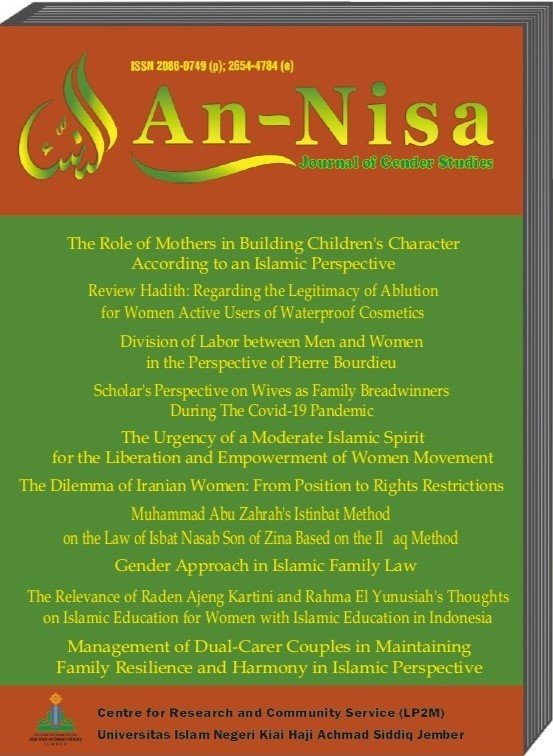Division of Labor between Men and Women in the Perspective of Pierre Bourdieu
DOI:
https://doi.org/10.35719/annisa.v16i1.131The division of tasks between husband and wife could be more balanced. Wives who work in the public sector still have a double burden with household chores that are still assigned to them. This article aims to describe how the division of labor between men and women in Curah Leduk Hamlet and how the structured process of helping husbands work in the coffee plantations by women in Curah Leduk Hamlet is a fulfillment of their daily family needs from the perspective of Pierre Bourdieu. Research on the structured process of helping husbands to work in coffee plantations for women in Curah Leduk Hamlet as a fulfillment of their daily family needs uses a naturalistic interpretive paradigm. Therefore, the research approach uses qualitative methods with this type of field research. The results of this study show that women in Curah Leduk Hamlet, in practice, still do domestic work but also help men work in the public sector. In view Pierre Bourdieu, this is because the socialization of the rural environment, such as the obligation of women to obey their husbands, the duties of being in the domestic space or taking care of the household and caring for children, are still carried out by women even when they become a wife. That is what forms this tradition to date.
References
Adlin, Alfathri. Resistensi Gaya Hidup. Jakarta: Jalasutra, 2006.
Aminudin. Fiqh Munakahat. Bandung: Pustaka Setia, 1999.
Ch, Mufidah. Psikologi Keluarga Islam Berwawasan Gender. Malang: UIN Malang Press, 2008.
Hardjodisastro, Daldiyono, Hardjodisastro Wistodiyono, and Ferdinandus Untoro Ardi. Ilmu Slamet: Merangkai Mutiara Filsafat Jawa Di Era Modernisasi Dan Globalisasi. Jakarta: PT Bhuana Ilmu Populer, 2010.
Harker, Richard K, Cheelien Mahar, Chris Wilkes, Saleh Rahmana, and Pipit Maizier. (Habitus x Modal) + Ranah = Praktik, Pengantar Paling Komprehensif Kepada Pemikiran Bordieu. Yogyakarta: Jalasutra, 1990.
Kinasih, Salma Rizkya, and Indri Wulandari. “Pembagian Kerja Berdasarkan Gender Dalam Pengelolaan Agroforestri Di Hulu DAS Citarum.” Umbara 6, no. 1 (July 31, 2021): 29. https://doi.org/10.24198/umbara.v6i1.33414.
Kusuma, Nila. “Pembagian Kerja Antara Suami Dan Istri Dalam Rumah Tangga Nelayan (Studi Di Kampung Nelayan Pondok Perasi Kelurahan Bintaro).” RESIPROKAL: Jurnal Riset Sosiologi Progresif Aktual 3, no. 1 (July 2, 2021): 45–57. https://doi.org/10.29303/resiprokal.v3i1.61.
Lestari, Sri. “Konsep Dan Transmisi Nilai-Nilai Jujur, Rukun, Dan Hormat.” Universitas Gajah Mada Yogyakarta, 2013.
Moleong, Lexy J. Metodologi Penelitian Kualitatif. Bandung: PT. Remaja Rosdakarya, 2017.
Puspitawati, Herien. “Analisis Structural Equation Modeling Tentang Relasi Gender, Tingkat Stres, Dan Kualitas Perkawinan Pada Program Keluarga Penerima Keluarga Harapan (PKH).” Yinyang: Jurnal Studi Islam, Gender Dan Anak 5, no. 2 (2010).
Ritzer, George. Teori Sosiologi: Dari Teori Sosiologi Klasik Sampai Perkembangan Terakhir Postmodern. Yogyakarta: Pustaka Pelajar, 2014.
Ritzer, George, and Douglas J. Goodman. Teori Sosial Modern. Jakarta: Prenada Media, 2004.
Setiawan, Eko. “KONSTRUKSI SOSIAL PEMBAGIAN KERJA DAN PENGUPAHAN BURUH TANI.” Yinyang: Jurnal Studi Islam Gender Dan Anak 12, no. 1 (June 23, 2017): 19–34. https://ejournal.uinsaizu.ac.id/index.php/yinyang/article/view/1130.
Siahaan, Hotman M., Suharnadji, Sindung Haryanto, Sri Sumartini, Trikuntari Dianpratiwi, Andi Suwarko, M. Lukman Hakim, et al. Anatomi Dan Perkembangan Teori Sosial. Malang: Aditya Media Publishing, 2010.
Suhendi, Hendi, and Ramdani Wahyu. Pengantar Studi Sosiologi Keluarga. Bandung: Pustaka Setia, 2001.
Suratman. Kamus Lengkap Psikologi. Jakarta: Rineka Cipta, 2000.
Syarif, Ahmad Arif. “Relasi Gender Suami Istri: Studi Pandangan Tokoh Aisyiyah.” UIN Sunan Kalijaga, 2016.
Yanggo, Huzaemah Tahido. Fikih Perempuan Kontemporer. Bogor: Ghalia Indonesia, 2010.
Downloads
Published
Issue
Section
License
Copyright (c) 2023 Muhammad Arif Mustaqim

This work is licensed under a Creative Commons Attribution-NonCommercial 4.0 International License.
















 AN-NISA licensed under Creative Commons Attribution-NonCommercial 4.0 International License.
AN-NISA licensed under Creative Commons Attribution-NonCommercial 4.0 International License.